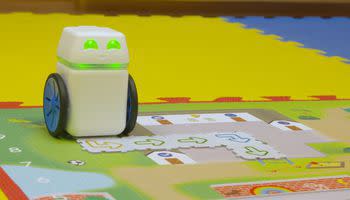7 women inspiring Twitter on the International Day of Women and Girls in Science

Scroll through Twitter, and you'll see the trending hashtag #WomenInScience. February 11 is International Day of Women and Girls in Science: a time to recognize the ladies making the world a better place through science and technology.
Their success stories should really be celebrated every day, especially because science remains a male-dominated field. Less than 30 percent of the world’s researchers are women, according to the UNESCO Institute for Statistics.
SEE ALSO: 8 ways you can empower girls to learn coding
Here are the inspiring stories of seven women who are getting extra Twitter love on this day of awareness. They've all achieved remarkable successes in science.
1. Alice Ball
Alice Ball died when she was just 24 years old due to chlorine poisoning, but she accomplished much in her short lifetime. She was the first African American and the first woman at the the University of Hawaii to earn a master's degree in chemistry in 1915. She also developed an treatment for leprosy, also known as Hansen's Disease, using the oil of a chaulmoogra tree. It was used for 20 years, according to National Geographic.
Today we honor chemist Alice Ball. Ball developed an injection that for decades was the most effective treatment for patients diagnosed with leprosy. She was also the first woman to earn a master’s degree in chemistry from the College of Hawaii. #BlackHistoryMonth #WomenInScience pic.twitter.com/yTeX8N2UbI
— The Undefeated (@TheUndefeated) February 11, 2019
2. Marie Curie
Marie Curie is a "first of" for many titles — including the first woman to win a Nobel Prize and the first person to win the award in two different sciences (physics —along with her husband— and chemistry). In 1906, she was also the first woman to become a general physics professor at the Sorbonne, where she took over her husband's role after his death.
Happy #WomenInScience Day! 👩🏻🔬 👩🏿🔬
Marie Curie is a great example of why we must invest in women and girls in science. pic.twitter.com/MCUD5Sbvcz— International Atomic Energy Agency (@iaeaorg) February 11, 2019
3. Barkissa Fofana
Barkissa Fofana is currently a microbiologist at Burkina Faso’s Institute for Environmental and Agricultural Research. She is just 30 years old, according to the Food and Agriculture Organization of the United Nations, and she's researching ways microorganisms can combat climate change and restore land in the northern Sahel region. One of her projects involves studying how Acacia trees respond to natural bacteria and fungi, in order to help the trees overcome droughts.
The incredible work of a young, female microbiologist from Burkina Faso is helping combat desertification in the Sahel.
Here is the story of Barkissa Fofana 👉https://t.co/ykZ4z5Uqln #WomenInScience 👩🔬👩🏿🔬👩🏻🔬👩🏽🔬👩🏾🔬 #ZeroHunger— FAO (@FAO) February 11, 2019
4. Rosalind Franklin
Rosalind Franklin almost didn't go to Cambridge University because her dad didn't believe in women getting a higher education. Luckily, she had her mom and aunt's support. There, she studied physical chemistry. She graduated in 1941, and 10 years later, got at job at King's College. She took an X-ray image, famously known as Photograph 51, that ultimately helped discover DNA's double helix structure.
🎉 Make a noise for all the amazing #WomenInScience as we celebrate #InternationalDayofWomenandGirlsinScience
🤩 Rosalind Franklin chemist, X-ray crystallographer and DNA pioneer https://t.co/YE2olrRepK
Inspiring the next generation of girls and young #WomenInSTEM pic.twitter.com/2nlUfqNTrx— Stemettes 💙 ★ # + (@Stemettes) February 11, 2019
5. Jane Goodall
Jane Goodall is known around the world for studying chimpanzees in Tanzania in 1960 and beyond. Through her research, she discovered the ins and outs of the animal's behaviors, such as using pieces of grass as a tool to eat insects and developing long-lasting relationships with one another.
We love our #WomenInScience every day, but today's a good day to recognize them! #JaneGoodall pic.twitter.com/8xWYb0BlV4
— Nat Geo Channel (@NatGeoChannel) February 11, 2019
6. Katherine Johnson
Thanks to her trajectory analysis, NASA mathematician Katherine Johnson helped take Alan Shepard to space — he was the first American to do so in 1961. Although she was hardly recognized at the time for contributions, the 2016 book and movie Hidden Figures changed that. She also received the Presidential Medal of Freedom from President Obama in 2015 in honor of those achievements.
Join us on 11 Feb, Int'l Day of Women & Girls in Science, to celebrate all the inspirational #WomenInScience! One of them is Katherine Johnson, who helped send 👨🚀 to the 🌕 with her calculations! pic.twitter.com/oJyyswIVFC
— UN Women (@UN_Women) February 7, 2019
7. Rita Levi-Montalcini
Rita Levi-Montalcini received the 1986 Nobel Prize in physiology or medicine for the discovery of nerve growth factor, which showed how the growth of a cell is regulated. Her work related to the nervous system helped deepen understanding of senile dementia, deformities, and tumor diseases. American biochemist Stanley Cohen shared the honor for discovering the epidermal growth factor.
Today we're celebrating pioneering neurologist Rita Levi-Montalcini, whose groundbreaking investigations into how the nervous system develops deepened understanding of medical problems like senile dementia, deformities and tumour diseases. #WomenInScience #NobelPrize pic.twitter.com/6okKGYSL30
— The Nobel Prize (@NobelPrize) February 11, 2019
WATCH: 5 fun toys that teach your kids coding — Optimize That


